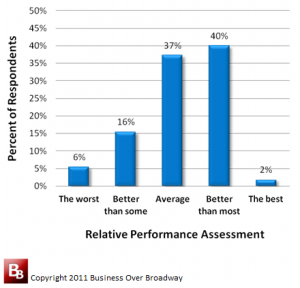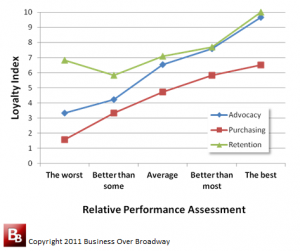Customer Experience Management (CEM) is the process of understanding and managing customers’ interaction with and perceptions about the company/brand. In these programs, customer experience metrics are tracked and used to identify improvement opportunities in order to increase customer loyalty. These customer experience metrics, used to track performance against oneself, may not be adequate for understanding why customers spend more with a company. Keiningham et al. (2011) found that a company’s ranking (against the competition) was strongly related to share of wallet of their customers. In their two-year longitudinal study, they found that top-ranked companies received greater share of wallet of their customers compared to bottom-ranked companies.
Relative Performance Assessment (RPA): A Competitive Analytics Approach
I developed the Relative Performance Assessment (RPA), a competitive analytics solution that helps companies understand their relative ranking against their competition and identify ways to increase their ranking, and consequently, increase purchasing loyalty. The purpose of this post is to present some data behind the method.
This method is appropriate for companies who have customers who use a variety of competitors. In its basic form, the RPA method requires two additional questions in your customer relationship survey:
- RPA Question 1: What best describes our performance compared to the competitors you use? This question allows you to gauge each customer’s perception of where they think you stand relative to other companies/brands in their portfolio of competitors they use. The key to RPA is the rating scale. The rating scale allows customers to tell you where your company ranks against all others in your space. The 5-point scale for the RPA is:
is the worst is better than some is average (about the same as others) is better than most is the best
- RPA Question 2: Please tell us why you think that “insert answer to question above”. This question allows each customer to indicate the reasons behind his/her ranking of your performance. The content of the customers’ comments can be aggregated to identify underlying themes to help diagnose the reasons for high rankings (e.g., ranked the best / better than most) or low rankings (ranked the worst / better than some).
RPA in Practice
I have applied the RPA method in a few customer relationship surveys. I will present the results of a relationship survey for a B2B software company. This particular company had customers that used several competitors, so the RPA method was appropriate. The results in Figure 1 show that, on average, customers think the company is a typical supplier in the space, with a few customers indicating extreme ratings.
Additionally, similar to the findings in the Keiningham study, I found that the RPA was related to loyalty measures (see Figure 2). That is, customers who rank a company high also report high levels of customer loyalty toward that company. Conversely, customers who rank a company low also report low levels of customer loyalty toward that company. This relationship is especially strong for Advocacy and Purchasing loyalty.
Relative Performance, Customer Experience and Customer Loyalty
To understand the importance of the relative performance, I wanted to determine how well the RPA explained customer loyalty after accounting for the effects of the customer experience. Along with the RPA, this relationship survey also included seven (7) general customer experience questions (e.g., product quality, support quality, communications from the company) that allowed the customer to rate their experience across different customer touchpoints and 5 customer loyalty questions measuring the three types of customer loyalty, retention, advocacy and purchasing.
Understanding the causes of customer loyalty is essential to any Customer Experience Management (CEM) program. To be of value, the RPA needs to explain differences in customer loyalty beyond traditional customer experience measures. I ran a stepwise regression analysis for each loyalty question to see if the Relative Performance Assessment helped us explain customer loyalty differences beyond what can be explained by general experience questions.

Figure 3. Relative performance (RPA) helps explain purchasing loyalty behavior. Improving relative performance will increase purchasing loyalty and share of wallet.
For each customer loyalty question, I plotted the percent of variance in loyalty that is explained by the general questions and the one RPA question. As you can see in Figure 3, the 7 general experience questions explain advocacy loyalty better than they do for purchasing and retention loyalty. Next, looking at the RPA question, we see that it has a significant impact on purchasing loyalty behaviors. In fact, the RPA improves the prediction of purchasing loyalty by almost 50%. This finding shows us that 1) there is value in asking your customers about your relative performance and 2) improving the company’s ranking will increase purchasing loyalty and share of wallet.
Understanding your Ranking
Further analysis of the data can help you understand your competitive (dis)advantage and the reasons behind your ranking. First, you can correlate the experience ratings with the RPA to see which customer experience area has the biggest impact on your relative performance. Second, content analysis of the second RPA question (e.g., why customers gave that ranking) can reveal the reasons behind your ranking. Applying both of these methods on the current data, I found a common product-related theme that might be responsible for their ranking. Specifically, results showed that the biggest customer experience driver of relative performance (RPA) was product quality. Additionally, the open-ended comments by customers who gave low RPA rankings were primarily focused on product-related issues (e.g., making the product easier to use, adding more customizability).
Summary
Companies that have higher industry rankings receive more share of wallet than companies who have lower industry rankings. The Relative Performance Assessment helps companies measure their performance relative to their competitors and help them find ways to improve their competitive advantage.





